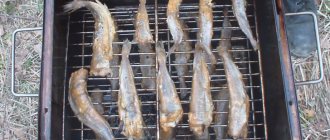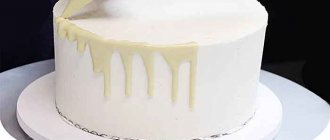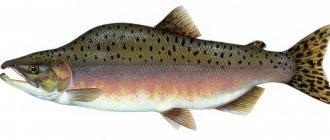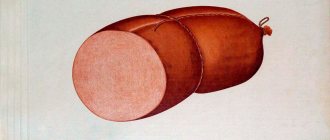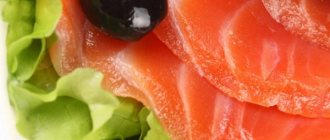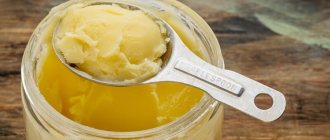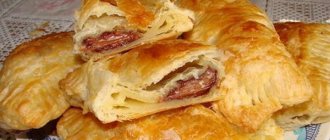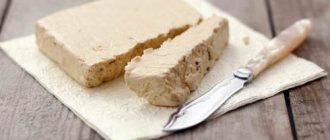© photocrew — stock.adobe.com
Share:
Trout is a freshwater red fish from the salmon family. The product has beneficial properties due to its saturation with fats, vitamins and amino acids. In addition, trout, due to its low calorie content, is suitable for dietary nutrition, and due to its high protein content, it can be included in the diet of athletes.
Fresh trout
A raw carcass has from 95 to 110 kcal per 100 grams of weight. Like any animal product, there are no carbohydrates in it, but there is 19 g of protein and 2.3 g of fat. The composition of the chemical elements of the fresh product is rich and consists of the following components:
- vitamins A and K (fat soluble);
- the whole range of B vitamins;
- trace elements including Ca, Mg, Cu and Zn;
- essential fats such as omega-3 and omega-6;
- unsaturated acids: linoleic, linolenic, palmitoleic and arachidonic.
Important! These elements are necessary for the harmonious functioning of the human body. Doctors proved many years ago that in modern living conditions it is important for people to eat fish dishes at least twice every seven days. And trout is the most suitable option for obtaining essential nutrients.
Lightly salted trout
Lightly salted fish has 186 kcal per 100 grams of weight. Its chemical composition contains elements as a percentage of the daily human consumption:
- vitamin B2 - 11.1% of daily intake;
- choline - 13%;
- vitamin B5 - 38.8%;
- vitamin B12 - 259.7%;
- vitamin D - 39%;
- vitamin E - 16.7%;
- vitamin PP - 50%;
- magnesium - 15%;
- phosphorus - 30.4%;
- iron - 13.9%;
- manganese - 42.6%;
- copper - 18.8%;
- selenium - 22.9%;
- chromium - 110%.
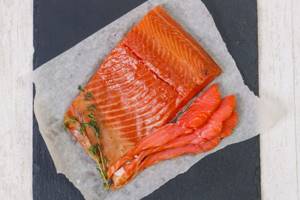
It’s easy to prepare lightly salted trout even at home:
- first of all, clean the fish carcass, and then separate the meat from the bones and backbone and rinse the fillet under running cold water;
- then we prepare a salty mixture of salt and sugar in proportions 2: 1. For a medium-sized fish, four tablespoons of salt and half as much sugar are required; pour as much of the pickling mixture into the prepared bowl as needed, place the trout fillet on it and sprinkle on top and sides;
- after 5-6 hours, turn the fish over and leave for the same amount of time; At the end of salting, remove the fish, rinse with cold water to remove any remaining salt and dry with napkins or paper towels.
Advice! If the fish suddenly tastes too salty, you need to soak it in cool water for several hours. After this, the fillet will become lightly salted and is perfect for sandwiches or snacks.
Recipe? Recipe!
What can be cooked from this fish? Yes, a lot of things! Here's a simple recipe:
Trout with sour cream:
We offer our readers the following recipe for preparing this fish. The dish turns out surprisingly tender and really tasty.
Products needed for cooking:
- Trout (fillet)
- Sour cream - 3 cups
- Garlic - 1 clove
- Parsley
- Salt
- Black pepper (to taste)
Preparation:
The fish fillet is cut into large pieces (in the shape of flat squares) 8-10 cm in size. Then the fish should be salted and peppered to taste. The garlic is finely chopped, the herbs are chopped - after which it is all mixed with sour cream and salted.
Place the cooked pieces of fish in a preheated frying pan with oil. Each piece should first be fried on one side for 5 - 7 minutes, then carefully turn it over and, using a spoon, place the prepared mixture of herbs, garlic and sour cream on the fried side. Then the fish is fried for about 5 - 7 minutes. The fish is decorated and the dish can be served. It is served still hot.
Steamed trout
This steamed dietary dish is tastier than boiled fish and trout will have 125 calories per 100 grams of weight, which also contains 17 grams of protein and 6 grams of fat. To prepare it you need:
- clean the trout, divide into medium-sized pieces so that one is enough for a serving;
- Rub the prepared trout pieces with salt, pepper and spices and leave to marinate;
- add a liter of water to a double boiler or saucepan and bring to a boil;
- place portions of fish in a steamer bowl or on a special steaming stand in a saucepan;
- after 15–22 minutes, turn the pieces over and wait the same time until fully cooked;
- At the end of the process, place on plates and add a side dish, also cooked in a double boiler, boiled vegetables or salad.
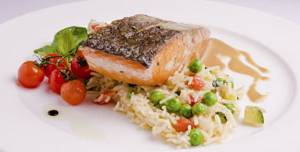
First fish dishes
Using trout, you can prepare incredibly tasty soups with vegetables and other common ingredients. Such recipes can compete with restaurant dishes. The efforts of the housewife will not go unnoticed, and your family will be pleasantly surprised. And preparation will not take much time.
In winter - ushitsa
In order to cook aromatic and very tasty fish soup, you need the following products:
- fish - 0.7 kg;
- potatoes - 4-5 pcs.;
- bulbs - 2 pcs.;
- carrots - half of one;
- salt, red and black pepper, bay leaf - to taste.
Carefully process and wash the fish, cut the carcass into small pieces. Cut the peeled potatoes into slices as for French fries, half the carrots into circles. Cut one onion into small cubes, and simply peel the second and leave it whole. Place chopped potatoes and a whole onion in a saucepan with water. There are also prepared carrots. Place the pan on the fire and when the water warms up a little, add the bay leaf to it.
Twenty minutes from the moment you turn on the stove, throw the fish into the water. Reduce the heat to medium intensity and cook the fish soup for ten minutes. Then add chopped onions into it. Five minutes before removing the finished fish soup from the heat, add salt and pepper to taste.
In the summer heat - botvinya
In the hot weather, you can pamper yourself and your household not only with traditional okroshka, but also with a dish that may rarely be prepared in your kitchen: botvinya with river trout. To prepare it you will need:
- fish - 0.5 kg;
- sour kvass (light) - 0.6 l;
- fresh cucumbers - 5 pcs.;
- salt and sugar - to taste;
- sorrel - 1 bunch;
- beet tops - 20 pcs.;
- young nettle leaves - 15 pcs.;
- spinach - bunch;
- dark kvass - 0.4 l;
- grated horseradish - 20 g;
- lemon zest - 20 g;
- sour cream, onion, dill, bay leaf, black pepper (peas) - to taste.
Get started cooking the trout right away. Peel it, gut it, wash it and boil it in water with salt, dill, onion, bay leaf and black peppercorns. Cool the cooked fish and cut into small pieces. Bring water to a boil in a separate large saucepan. Meanwhile, chop all the greens. When the water boils, throw the greens into it and let it cook for a couple of minutes. Then drain the greens in a colander and dry.
Peel fresh cucumbers and remove large seeds if you have taken very mature vegetables. Cut them into small cubes. Mix both types of kvass in a saucepan, add lemon zest and finely grated horseradish. Send greens and cucumbers there too. Add salt and sugar to taste. Place in the refrigerator for a couple of hours.
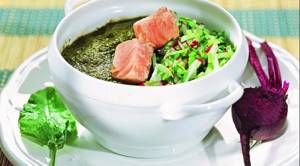
Before serving, form each portion as follows: place trout and a little sour cream on the bottom of the plate, and then pour botvina on top. If you do not want to increase the calorie content of the dish, then you can skip the sour cream and do not add a lot of sugar.
Baked trout
This is a fragrant recipe and here the trout has a calorie content per 100 grams of weight of 170 kcal and also contains 22 grams of protein and 9 grams of fat. To bake a product you need to do the following:
- clean the trout, wash it, dry it and cut it into steaks, two cm thick or a little more;
- Sprinkle each portion of fish with lemon juice and salt, rub with a mixture of pepper and fish spices. Leave to marinate for half an hour;
- Grease a special dish (you can use foil) for the oven with vegetable fat and place portioned pieces of fish in it. If you want, you can put vegetables on top (onions, peppers, eggplant, etc.);
- First, preheat the oven to +180C, place the dishes with fish in it and cook for up to 40–50 minutes.
This dish can be eaten cold or hot. In general, there are a lot of ways to cook fish in foil.
Important! Watch the preparation carefully! In different ovens, due to the power of the oven, the cooking time may differ greatly from that stated in the recipe. Also, baked fish can be cooked whole, if the carcass is not large, less than two kilograms.

TROUT EAR, COOKED IN A MULTICOOKER-PRESSURE COOKER
To prepare trout fish soup cooked in a pressure cooker, you will need the following ingredients:
- trout – 500 g
- water - 2 l
- potatoes - 300 g
- onion - 100 g
- carrots - 100 g
- bay leaf - 2-3 pcs
- allspice peas – 5 pcs.
- small red pepper - 1 pod
- salt

- dill greens - 1 bunch
- parsley - 1 bunch

COOKING METHOD:
- Pour 2 liters of water into the bowl of the multicooker-pressure cooker.
- Clean the trout, cut into portions, and place in a bowl.
- Peel the onion, chop it as usual for soup and put it in the bowl.
- Peel the carrots, cut into slices and place in a bowl.
- Peel the potatoes, cut them into cubes and place them in a bowl.
- Add salt, bay leaf, sweet peas, and pepper pod to the broth.
- Turn on the “Soup” mode for 20 minutes.
- We cut the dill and parsley.
- After cooking, release the steam, open the lid and add chopped greens to the soup.
- Let the ear brew in the “Warming” mode for 15 minutes.
Well, the soup is ready, you can try it.
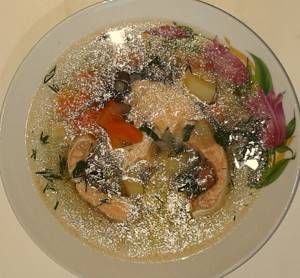
Enjoy your meal.
Fried trout
In this cooking method, fried fish absorbs some of the oil, due to which the fat content of the finished dish becomes greater. Therefore, the calorie content will already be 215 kcal per 100 grams of weight, and the protein content will be 19 g and fat 14 g. To prepare fried trout, this is the recipe:
- Clean the trout, rinse and dry. If the carcass is small, then it can even be fried whole; large fish should be cut into pieces;
- then marinate the fish for about an hour, pouring lemon juice on it and rubbing it with a mixture of salt and seasonings;
- heat the frying pan and pour a small amount of vegetable oil onto it; Dip fish pieces in flour on all sides and place in a frying pan;
- cook until golden brown, turning the pieces as needed; Cool portions and place on plates with a boiled side dish or salad. Fish can be eaten cold or hot.

Chemical elements in trout and their effect on the human body
Trout is beneficial not only because of its low calorie content, but also because it contains a lot of necessary and irreplaceable elements. The following have a beneficial effect on people's health:
- vitamin PP - corrects blood glucose levels, reduces bad cholesterol and therefore is a good method of therapy and prevention for high blood glucose, helps the heart and blood vessels function better, takes part in many chemical processes in the human body, therefore reducing the risk of diseases hearts;
- phosphorus - improves brain activity;
- chlorine - takes part in maintaining water balance and metabolism, in the secretion of gastric juice;
- sulfur - stimulates the growth of nails and hair and improves the skin;
- iron - simply vital for normal hemoglobin levels;
- zinc - increases immunity levels and helps brain function and memory;
- copper - promotes healthy skin and hair;
- selenium - removes free radicals from the body, inhibits the withering of the body, thanks to which the health and beauty of the body is maintained longer, and also inhibits the occurrence of malignant formations;
- manganese - strengthens the cardiovascular and nervous systems, participates in the production of hormones and improves immunity;
- iodine - vital for the functioning of the thyroid gland;
- chromium - promotes the elimination of fats and regulates insulin levels;
- fluoride - makes teeth strong;
- molybdenum - regulates blood glucose, destroys carcinogens, takes part in the processes of metabolism and synthesis of substances;
- Nickel - is part of cell DNA and increases metabolism; vitamins A and E are antioxidants;
- B vitamins - protect against stress and depression, help brain activity, regulate metabolism, strengthen the immune system and the condition of the skin, nails and hair;
- vitamin D - without which it is impossible to maintain healthy bones, cartilage and nerves; Omega-3 acid - preserves youth, prevents cancer, heals the heart and blood vessels, helps the human reproductive organs function well.

What are the benefits and how can trout be harmful?
Trout has a very good effect on brain activity, increases performance, reduces fatigue, improves memory and attention. This product is able to protect against the development of atherosclerosis, reduces nervousness and anxiety, fights stress, and has a preventive effect against the development of cancer. Eating this fish helps the body get rid of waste and toxins, correct blood pressure, and improve the general condition of diabetes and psoriasis. What makes trout a very popular product is its hypoallergenic nature. The special amount of KBJU makes this fish simply irreplaceable for people who are being treated for obesity or simply want to keep their body weight under control.
There is very little harm from trout, but several breeds of fish sometimes contain mercury, which can be dangerous for pregnant and breastfeeding women, so it is not advisable for them to eat a lot of it.
People who experience heavy physical activity may become deficient in energy and nutritional value due to the low calorie content of trout. Therefore, they need to combine this product with side dishes that are high in carbohydrates and calories and keep track of the BJU. And it’s best to bake or fry fish.
Important! Patients suffering from severe and chronic diseases of the gastrointestinal tract and internal organs (liver, kidneys) should definitely consult with their doctor about including trout and BJU in the diet, especially breeds with high fat content.
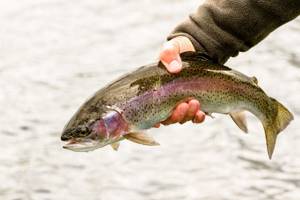
Contraindications and harm
Contraindications for consumption and harm to trout for health are primarily related to the ability of seafood products to accumulate heavy metals such as mercury. This element, even in the smallest quantities, is harmful to the body, so it is not recommended to overuse fish. A sufficient frequency of trout consumption is up to 3 meals per week.
In addition, you should avoid red fish:
- if there is an individual intolerance to the product or an allergic reaction;
- during lactation and pregnancy, women should refrain from eating trout, especially salted, as salt retains fluid in the body and aggravates the swelling already present during pregnancy;
- You should not eat raw fish - the product may be affected by parasites, so heat treatment is required;
- If you have diseases of the liver or gastrointestinal tract, eating red fish is contraindicated;
- eating salted or fried trout is contraindicated in case of cardiac ischemia, hypertension or atherosclerosis;
- to lose weight, you need to give up salted trout, as it retains fluid in the body;
- Salty foods should be avoided if you have kidney disease, since salt in the body will increase the amount of fluid consumed, which will lead to additional stress on the organ.
It is important to know: some varieties of fish are capable of accumulating mercury in greater quantities than others, but in order not to remember all varieties, it is enough to remember the general rule: the larger the fish, the higher the content of heavy metals in the meat. Brook trout is one of the fish species that accumulates mercury in lower quantities.
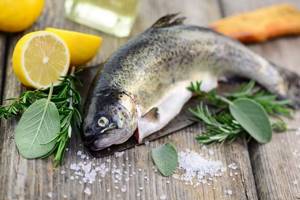
© Printemps — stock.adobe.com
Selection and storage of trout
Fresh chilled trout should feel firm to the touch and the scales should be slippery. The fish's eyes will appear clear and not covered with a dull veil, and the gills will be a bright dark red hue. A fresh carcass should not have any unpleasant odors, even fishy ones. This product cannot be stored for a long time and is best prepared immediately. As a last resort, fresh fish can be stored in the refrigerator, but not longer than a day.
If you need to increase the shelf life of trout, it is better to freeze it. Then all its beneficial substances and taste characteristics will be preserved.
There are many breeds and varieties of trout. There is a difference in appearance, chemical composition and even in habitat (sea, river, stream, lake). If a person needs to increase efficiency and gain strength, then it is better to eat fatty sea trout. And when the goal is to lose weight, then nutritious river fish is best, especially steamed or boiled.
Advice! When eating sea fish, you must cut off the head, because all the harmful elements contained in the water where this fish lived are concentrated in it.
Trout is a fish of the highest category, because it is found mainly only in clean waters, due to which it has a reputation for being very environmentally beneficial and not polluted.
Composition, nutritional value and calorie content
The calorie content of trout depends directly on the method of preparing the fish, and its composition and nutritional value also depend on the variety. The calorie content of raw trout per 100 g is on average 96.8 kcal, which is considered low, given that the fish is a fatty variety. The fattier rainbow trout has slightly higher calories at 140.6 kcal.
Depending on the cooking method, the number of calories changes as follows:
- baked in the oven - 102.8 kcal;
- fried in a frying pan with butter – 210.3 kcal;
- steamed – 118.6 kcal;
- lightly and lightly salted – 185.9 kcal;
- smoked – 133.1 kcal;
- salty – 204.1 kcal.
It is more than obvious that while following a diet, it is necessary to eat baked or steamed fish, since thanks to this technology for preparing the product, the maximum amount of useful components will be preserved. Salted, lightly salted and smoked fish cannot be called particularly healthy.
Nutritional value (BJU) of fresh trout per 100 g:
- proteins – 21 g;
- fats – 6.5 g;
- carbohydrates – 0 g;
- water – 72.0 g;
- ash – 1.1 g;
- cholesterol – 56 mg;
- omega-3 – 0.19 g;
- omega-6 – 0.39 g.
Chemical composition of minerals per 100 g:
- potassium – 363 mg;
- magnesium – 21.9 mg;
- sodium – 52.5 mg;
- phosphorus – 245.1 mg;
- calcium – 42.85 mg;
- iron – 1.5 mg;
- copper – 0.187 mg;
- manganese – 0.85 mg;
- zinc – 0.6 mg.
In addition, trout is rich in vitamins, such as:
- A – 16.3 mg;
- B1 – 0.4 mg;
- B2 – 0.33 mg;
- B6 – 0.2 mg;
- E – 0.2 mg;
- B12 – 7.69 mg;
- C – 0.489 mg;
- K – 0.09 mcg;
- RR – 4.45 mg;
- D – 3.97 mcg.
Trout contains up to 8 non-essential and 10 essential amino acids, which have a positive effect on women's and men's health.
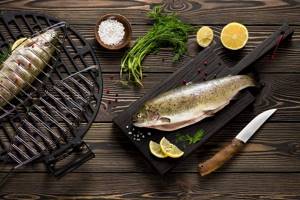
© nioloxs — stock.adobe.com
